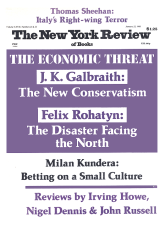We couldn’t, thinks ex-Marine Sergeant Manchester, take Tarawa again (or Guadalcanal or Iwo Jima or Okinawa). Today’s young wouldn’t plod “patiently on and on”—chest-deep in water, weapons over their heads, keeping formation—“while their comrades were keeling over on all sides.” That isn’t the only message of Manchester’s return, in memory and in person, to Pacific battlegrounds, but it’s the one that is most likely to force a reaction from the reader—while he can easily remain indifferent to (even skeptical of) Manchester’s personal quest for the reason he left a hospital bed, before Okinawa, to rejoin his men. It was—as he puts it at the climax of the book—“an act of love.”
The entire reconnaissance, Manchester says, was touched off by the appearance in his dreams of his young, tough, uncompromising self, reproaching his present “portly, Brooks-Brothered” mid-Fifties self: “what had happened in the third of a century since he had laid down his arms?” We then back up to the distinguished Manchester lineage; his (wounded) Marine veteran father and Old-Southern mother; his timid, picked-on childhood; his auspicious start at Amherst; his early enlistment in the Marines, love of rugged Parris Island, hatred of competitive Quantico OCS (he wittingly washed out); his hookup with the “military misfits”—most of them “liberal arts majors from old eastern colleges”—whose sergeant he was slated to be; and his two pre-embarkation attempts to lose his virginity (both aborted—one in part by “my outsize genitalia”—and neither quite credible).
Also worked into the foregoing are the attack on Pearl Harbor, the loss of the Philippines, and the Herculean securing of New Guinea—which brings the Pacific war, and Manchester’s unit, to Guadalcanal. Whatever one thinks of both stories so far (or of the coupling—a kind of personalized pop history), Manchester’s subsequent chronicle of debilitating jungle warfare on one after another “dumb island” (as a fed-up Marine put it) has an undeniable impact—not because the botched landing at Tarawa, for instance, is news, but because time has diminished neither the horror nor Manchester’s outrage. At first, too, his reference to the Japanese as “Japs” or “Nips” rankles; and one recoils when he writes, early on, “thank God for the atomic bomb.” But his description of Japanese tactics—first the suicide attacks, then the suicidal last stands—demonstrates why he’s still appalled at the prospect of storming mainland Japan. What he finds on these islands now is of variable interest or noteworthiness (the native culture corrupted; Japanese tourists and/or businessmen) until he reaches Saipan, where Allied forces first encountered Japanese civilians; at the island’s fall, all 18,000 hurled themselves off two cliffs…and their bodies are still being recovered and cremated, so the ashes can be returned to Japan.
The eventual death of most of Manchester’s men on Okinawa’s Sugar Loaf is more immediate but not more unnerving. And his farewell to his Sergeantself—atop today’s built-over Sugar Loaf—seems if anything a cheapening artifice. As for the upright, moral, industrious pre-World War II America that he deems responsible for his generation’s sacrifice, it will not be recognized by many of his contemporaries (“Mothers were beloved, fathers obeyed”; “To accept unemployment compensation, had it existed, would have been considered humiliating”). But one can dissent from much of Manchester’s moralizing and still be shaken by his chronicle of war.
Erik Zimen began his inquiry into the genetics of wolf behavior at a former forester station in northern Germany, where he originally intended to study the offspring obtained from crossing wolves and poodles. He soon gave up on the “puwo” project and concentrated on comparing wolf and poodle behavior, including poodles in order to observe the genetic effects of domestication.
In this study and later, in the Bavarian forest, he took the cubs and pups soon after birth to prevent their acquiring any learned behavior from their mothers. He kept the species in separate enclosures, though the first adoptee, a female wolf cub, was raised in the Zimens’ living room. She became closely attached to him until, some time after attaining sexual maturity, she turned against him so violently that he had to break off contact with her. This is common, Zimen found, among dominant wolves of both sexes, but especially the female; and would-be wolf owners should take heed.
Among the wolves themselves, Zimen reports, dominance battles were fiercest among the females. Contrary to the conclusions of other observers, he comments on the absence of rank order among cubs—though dominance relationships based on size emerge at feeding. Poodle puppies, he reports, show more rank order; they also show more size discrepancy between male and female pups. Among adult wolves, Zimen concludes that dominance relationships are complex and delicate. The mythical autocratic leader does not exist; all members of the pack contribute to decision-making, though not to the same extent.
Advertisement
Zimen questions some of Lorenz’s assumptions about wolves’ expressions of fear and aggression; he examines the workings of the “selfish gene” in pack relationships and cub rearing; considers wolf ecology and its effect on prey and the environment; and, in an account of his work on a wolf census in Italy, looks at human behavior toward wolves and the influence of human populations on wolf behavior. This is a thorough, intelligent, consistently readable, sometimes provocative report—miles ahead of the romantic portrait that has recently prevailed.
This Issue
January 22, 1981



